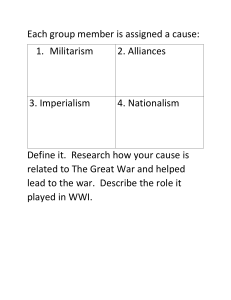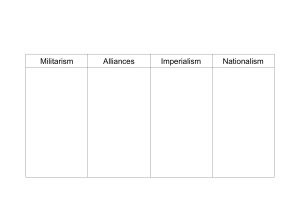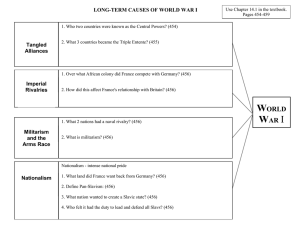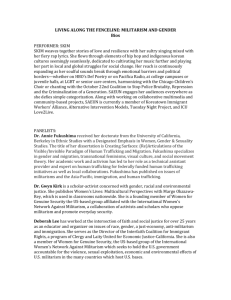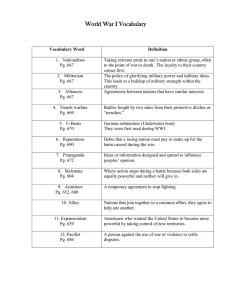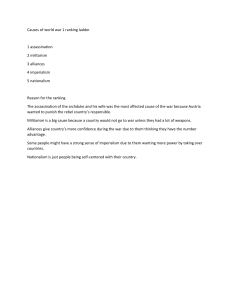APznzabf1MVQsOpneR2SWjF3zBYBRxNEqmiP8DQLEm6i1vlSkpidRX69rvHPXUWAcCF6qksZ8mNE5rp6gP Fje aBOMSvlkMDN4UBVuDhiLxBqLwsYoLQa5SfwDX qTHTA8viWPTDvsoEwTteQd3Zj7J0mU07Td9I2SIXZhaAKvCTPO8CTkio8lICHh3aNiBxwigW7
advertisement
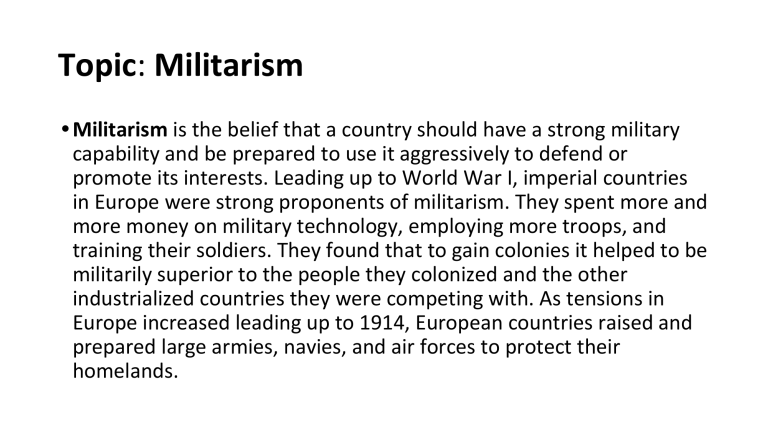
Topic: Militarism • Militarism is the belief that a country should have a strong military capability and be prepared to use it aggressively to defend or promote its interests. Leading up to World War I, imperial countries in Europe were strong proponents of militarism. They spent more and more money on military technology, employing more troops, and training their soldiers. They found that to gain colonies it helped to be militarily superior to the people they colonized and the other industrialized countries they were competing with. As tensions in Europe increased leading up to 1914, European countries raised and prepared large armies, navies, and air forces to protect their homelands. Militarism In militaristic nations, generals and admirals often act as de facto government ministers or officials, advising political leaders and influencing domestic policy. Not surprisingly, this leads to significant increases in defence and arms spending. Late 19th and early 20th-century militarism fuelled an arms race that gave rise to new military technologies and increased defence spending. Militarism also shaped culture, the press and public opinion. Newspapers held up military leaders as heroes, painted rival nations as dangerous aggressors and regularly speculated about the possibility of war. Militarism • In the 19th century European mind, politics and military power became inseparable, much like politics and economic management have become inseparable in the modern world. Governments and leaders who failed to maintain armies and navies to protect the national interest were considered weak or incompetent. Prussian Militarism • Prussia was always seen as the embodiment of military prowess and power. It was, in many ways, a state that was built by an army. Its sense of militarism spread dramatically to its soldiers and civilians, affecting their societies, politics, and culture. Weapons Used in WW1 Depth charge • Depth charges were first developed by the Royal Navy during World War I to combat German submarines. Military aircraft • World War I was a crucible for military aircraft development. Between 1914 and 1918, planes advanced from barely airworthy craft to effective weapons platforms. Military aircraft. Rifle • Infantry weapons underwent a massive change in the late 19th century, as repeating rifles entered widespread use. The World War I infantryman could produce a volume of fire that dwarfed that of his mid-19th-century predecessors. Zeppelin • Zeppelin • German airships achieved moderate success in long-range bombing operations, as Zeppelins could attain higher altitudes than the airplanes of the era. CHEMICAL Weapons Chemical weapons Chemical weapons, such as diphosgene and mustard gas, were employed extensively on the Western Front. Artillery • Artillery literally shaped the battlefield in World War I. It ranged in size from the French 75-mm field gun to the massive 420-mm Big Bertha and the 210-mm Paris Gun. • Cavalry • Despite the advances in technology, cavalry retained a significant role in World War I, and horses died by the millions in the conflict. • Battleship • The age of the battleship reached its apotheosis in World War I, as even the Dreadnought, the archetypal “big gun” ship, found itself outgunned. Super dreadnoughts, such as the HMS Orion, ruled the waves; their reign was short, however, as developments in naval aviation would soon render such ships obsolete Battleship • Machine guns • Machine guns were an exceptionally lethal addition to the battlefield in World War I. Heavy guns, such as the Maxim and Hotchkiss, made “no man's land” a killing zone, and Isaac Newton Lewis's light machine gun saw widespread use at the squad level and as an aircraft armament. Tank • Tanks were used primarily in a supporting role. The armored vehicle would not truly come into its own until the doctrines of J.F.C. Fuller and Basil Liddell Hart were more widely adopted in World War II.
